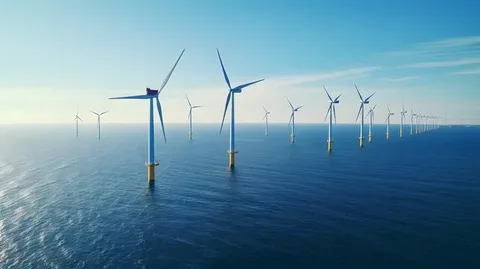| Introduction The Ocean Wind Farm Market represents a transformative shift in global energy generation, utilizing offshore wind resources to deliver clean, renewable power at scale. As governments and corporations accelerate decarbonization targets, ocean wind projects—particularly floating and deepwater installations—are becoming strategic assets in the global energy transition. Rising energy demand, coupled with increasing pressure to reduce carbon footprints, has positioned ocean wind farms as one of the fastest-growing renewable sectors. The integration of advanced turbine technologies, digital monitoring systems, and hybrid offshore platforms is creating new efficiencies and opportunities across global markets. Market Drivers The primary driver for the ocean wind farm market is the growing global commitment to renewable energy and carbon neutrality. Many countries, including the United Kingdom, Germany, China, and the United States, have set ambitious offshore wind capacity goals, often supported by strong policy incentives and government-backed funding. The declining levelized cost of electricity (LCOE) for offshore wind—due to advancements in turbine design, blade materials, and installation methods—has made the technology increasingly competitive with fossil fuels. Additionally, the scalability of offshore sites allows for the deployment of high-capacity turbines without the land constraints faced by onshore projects. Corporate power purchase agreements (PPAs) and international green investment funds are also driving capital flow into ocean wind infrastructure, fostering innovation and rapid market expansion. Market Challenges Despite significant growth, the market faces several technical and economic challenges. The high capital expenditure (CAPEX) and operational expenditure (OPEX) associated with offshore wind farm construction, maintenance, and grid connection remain key barriers. Environmental concerns, such as potential disruptions to marine ecosystems and the complex permitting process for seabed leasing, can delay project timelines. Supply chain constraints—especially for subsea cables, specialized vessels, and turbine components—are leading to project bottlenecks and cost inflation. Furthermore, fluctuating steel and raw material prices can significantly affect project economics. Technical challenges also include grid integration, the need for advanced energy storage systems, and resilience against extreme weather conditions in deep-sea environments. Market Opportunities The ocean wind farm market offers substantial opportunities for innovation and investment. Floating wind technology, which allows turbines to be installed in deeper waters, opens vast new geographical areas for development, particularly in regions like Japan, South Korea, and the U.S. West Coast. Integration with green hydrogen production presents another major opportunity, as offshore platforms can generate hydrogen directly from seawater using renewable electricity, helping decarbonize industrial sectors. The growing trend of hybrid energy systems—combining wind with solar or tidal energy—enhances energy reliability and output stability. Additionally, digitalization through IoT sensors, predictive analytics, and remote monitoring systems improves maintenance efficiency and reduces downtime. Emerging economies are also presenting new frontiers for investment as they begin to adopt offshore wind strategies to meet future energy security goals. Regional Insights Europe currently dominates the ocean wind farm market, with the United Kingdom, Germany, and the Netherlands leading large-scale offshore installations. The European Union’s ambitious Green Deal and offshore renewable energy strategies have driven massive regional investment in wind infrastructure and grid interconnections. Asia-Pacific, particularly China, is rapidly expanding its offshore capacity, now accounting for a significant share of global installations. Japan and South Korea are investing heavily in floating wind technology to overcome deepwater challenges. North America, led by the United States, is entering a high-growth phase, with states like New York and Massachusetts committing billions to offshore projects and transmission infrastructure. Emerging markets in Latin America and the Middle East are also exploring offshore wind as part of broader diversification and sustainability initiatives. Future Outlook The future of the ocean wind farm market looks promising, with global capacity expected to grow exponentially over the next decade. Technological advancements will continue to drive cost reductions and enhance reliability, while innovations in floating turbines and energy storage integration will expand market reach. Policy support and public-private partnerships will remain crucial in accelerating deployment and addressing grid connection challenges. By 2035, ocean wind farms are expected to play a pivotal role in achieving net-zero emission targets and powering large segments of coastal cities and industries. The fusion of digital technologies, AI-driven maintenance, and sustainable materials will further redefine operational efficiency and environmental responsibility. Conclusion The Ocean Wind Farm Market stands at the forefront of global renewable transformation, embodying the synergy between innovation, sustainability, and energy security. As nations race to meet clean energy commitments, ocean wind projects are proving indispensable in shaping the future energy landscape. With continued technological evolution, supportive policy frameworks, and strategic global investments, the market is set to experience sustained and diversified growth across all regions in the coming decade. |
